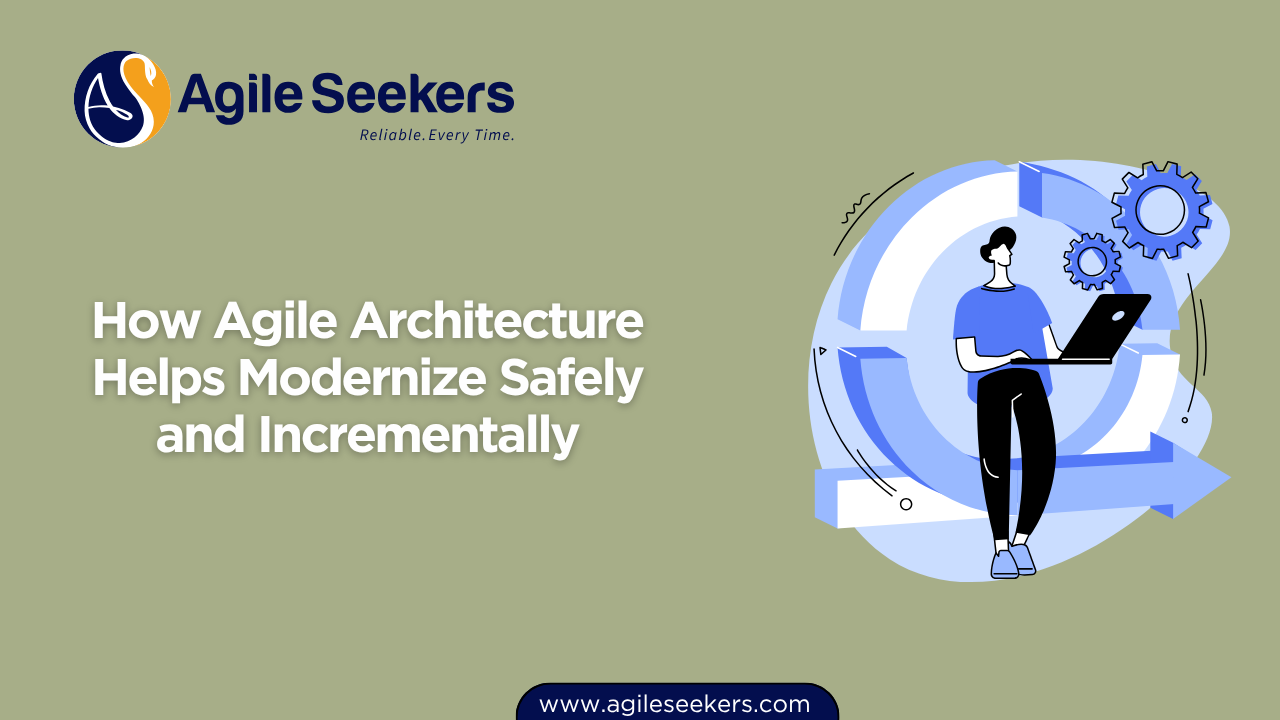How Agile Architecture Helps Modernize Safely and Incrementally

Modernizing legacy systems is no longer a one-time event—it’s a continuous journey. Organizations working with aging software often struggle with balancing the need for innovation with the risk of breaking stable systems. Agile Architecture provides a disciplined yet flexible approach to evolve these systems incrementally without interrupting the flow of value.
This blog explores how Agile Architecture supports safe, incremental modernization and helps organizations build systems ready for the future—while delivering consistently in the present.
The Modernization Challenge
Legacy systems often form the backbone of business operations. They’re critical—but rigid. Replacing them outright poses risk. Freezing delivery to “rewrite everything” isn’t an option for most enterprises that depend on continuous value flow.
The key lies in striking a balance: evolve what’s necessary, maintain what works, and do it in small, measurable steps.
That’s where Agile Architecture fits in.
What Is Agile Architecture?
Agile Architecture isn’t about dictating a fixed structure. It’s about enabling change. It supports decentralized decision-making, rapid learning, and collaboration across business and technology roles.
SAFe® defines Agile Architecture as a set of values, practices, and collaboration patterns that enable teams to evolve systems design while maintaining alignment with business goals and the architectural runway.
Instead of designing everything up front, Agile Architects create just enough structure to support today’s needs while allowing systems to evolve smoothly over time.
Core Strategies to Modernize Incrementally
1. Architectural Runway for Incremental Change
The architectural runway provides the foundation to implement near-term features without significant redesign. It includes code, components, and infrastructure already in place to support upcoming work.
By continuously extending the runway through Enabler Epics and Features, teams can evolve architecture step by step—avoiding big-bang overhauls.
✅ Learn more about architectural runway from the Scaled Agile Framework.
2. Decompose Monoliths into Services Gradually
Rather than breaking apart a legacy system all at once, Agile teams use techniques like strangler fig patterns, wrappers, and service facades to extract functionality one domain at a time.
This method supports the transition from monoliths to microservices or modular architectures without disrupting current operations.
Agile Product Owners and Product Managers, especially those certified through the SAFe Product Owner/Product Manager (POPM) Certification, play a vital role in this shift by prioritizing modernization work that aligns with customer and business value.
3. Feature Toggles and Branch by Abstraction
To introduce architectural changes safely, teams can use feature toggles to deploy code without exposing unfinished features. Similarly, branch by abstraction allows internal structures to change without impacting external behavior.
These practices let architects and teams validate new designs while continuing to deliver value every iteration.
This is where Scrum Masters become crucial. Through SAFe Scrum Master Certification, they learn how to facilitate technical discussions and help teams adopt these safe deployment techniques.
4. Set Up Architecture Enablers in Program Backlogs
Modernization should be visible and planned—not an afterthought. By framing modernization work as enabler stories or enabler features, teams ensure it gets prioritized, estimated, and delivered within Agile Release Trains (ARTs).
Release Train Engineers, trained through the SAFe Release Train Engineer Certification Training, play a critical role in keeping the modernization vision aligned with the ART’s objectives.
5. Architectural Decision Records (ADRs)
As legacy systems evolve, documenting decisions becomes essential. Agile teams use Architectural Decision Records (ADRs) to keep track of why specific changes were made, what options were considered, and what trade-offs were accepted.
This improves transparency and ensures future teams understand the reasoning behind current architecture.
Agile Architecture in SAFe: Guardrails, Not Constraints
One of the strengths of Agile Architecture in SAFe is that it provides guardrails, not gates. Enterprise Architects don’t micromanage teams. Instead, they enable local decision-making while aligning technical direction with long-term business strategy.
This balance empowers agile teams while maintaining cohesion across large systems.
Leaders trained through the Leading SAFe Agilist Certification are equipped to support this collaborative architectural model and integrate technical decisions into strategic planning.
Collaboration Between Architects and Teams
Agile modernization is not an isolated architectural task—it’s a team sport. System Architects, Product Managers, Engineers, and Scrum Masters must collaborate daily.
Advanced-level facilitators like those with SAFe Advanced Scrum Master Certification are trained to bridge communication across technical and business roles, ensuring alignment and flow.
This multi-role engagement ensures architectural work is not disconnected from day-to-day delivery, which helps avoid “ivory tower” design.
Measuring Progress Without Slowing Down
Modernization work can feel invisible. That’s why teams need to define clear, measurable goals—like reducing code complexity, shortening build times, or improving test coverage.
Flow metrics, such as Flow Time and Flow Efficiency, can also help assess how modernization efforts impact overall delivery. These indicators are now part of the SAFe Framework's emphasis on Flow-based thinking.
Read more on Flow Metrics in SAFe to understand how modernization can be measured alongside value delivery.
A Realistic Approach to Legacy Evolution
Agile Architecture does not promise instant results. It offers a sustainable path forward, allowing modernization to evolve alongside new feature development. It avoids system paralysis, reduces technical debt gradually, and fosters business agility.
Key takeaways:
-
Don’t wait for “the right time” to modernize. Start small, align with value, and build momentum.
-
Use architectural enablers, decoupled services, and lightweight governance to support change.
-
Collaborate across roles and make technical decisions visible and testable.
Organizations that embrace Agile Architecture build systems that are both resilient and responsive—ready for what’s next, without compromising what works now.
For training that enables you to lead or support Agile modernization effectively, explore:
These certifications can help you apply architectural thinking to real-world delivery challenges, making modernization a shared responsibility across your Agile enterprise.
Also read - Principles of Agile Architecture in SAFe: A Guide for Enterprise Leaders
Also see - Why Traditional Fixed‑Price Contracts Fail in Agile Environments?




















